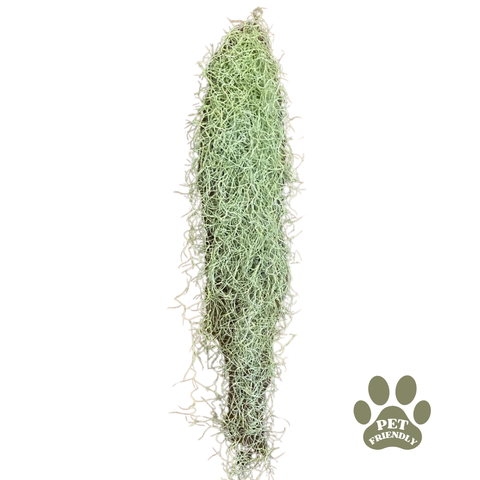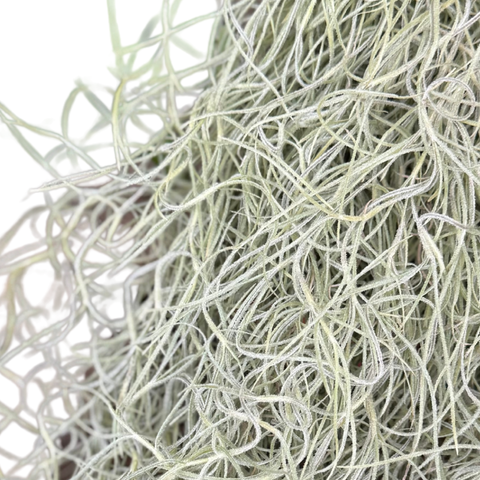

Tillandsia usneoides - Spanish Moss
Aroma Quartz📦 FREE SHIPPING OVER £40
Size: 40-60cm
Tillandsia usneoides
Common Names: Spanish Moss, Hanging Moss, Old Man’s Beard
Full Botanical Name: Tillandsia usneoides
Country and/or Region of Origin: Native to the southeastern United States, Central and South America, and parts of the Caribbean
Overview
Tillandsia usneoides, commonly known as Spanish Moss, is a unique and eye-catching air plant that drapes beautifully from tree branches or can be displayed in hanging planters. Its silvery-green, thread-like foliage creates a soft, flowing effect, adding a touch of whimsy and rustic charm to any space. Known for its ability to thrive without soil, this epiphytic plant is perfect for creating boho-style decor, terrariums, or adding texture to arrangements.
Growing Conditions in Native Habitat
In its natural habitat, Spanish Moss grows on trees, particularly in humid environments like swampy areas, where it thrives in filtered light and high humidity.
Care Guide
Light: Prefers bright, indirect light but can tolerate some direct sunlight. Too much direct sun can cause the leaves to dry out and turn brown.
Ideal Room: Perfect for living rooms, kitchens, or bathrooms with consistent light. It also makes a lovely addition to hanging planters, terrariums, or mounted on branches for a natural look.
Feeding: Feed once a month during the growing season (spring and summer) with a diluted air plant fertilizer. During the cooler months, reduce feeding.
Humidity: Prefers high humidity. Mist the plant regularly or soak it in water for 20-30 minutes every 1–2 weeks, especially during dry months. The more humidity it gets, the better it will thrive.
Ideal Temperature: Thrives in temperatures between 50–90°F (10–32°C). Protect from cold drafts and freezing temperatures.
Watering: Soak the plant in water for 20–30 minutes once a week, or mist it regularly to keep it hydrated. After soaking, allow it to dry completely in a well-ventilated area to prevent rot.
Pet/Child Safe: Non-toxic and safe for pets and children, making it an ideal addition to homes with animals or young ones.
Soil Type: As an epiphyte, Spanish Moss does not need soil. It absorbs nutrients and moisture through its leaves, making it easy to care for with minimal maintenance.
Propagation: Tillandsia usneoides can be propagated by division. Simply pull apart small sections of the plant and allow them to root independently.
Eventual Height and Spread: The plant can grow up to 10-20 feet (3-6 meters) in its natural habitat, but as an indoor plant, it generally stays much smaller, growing long, trailing strands that can reach 2-3 feet (60-90 cm) when displayed.
Growth Rate: Slow to moderate. It can take time to establish, but once it does, it will thrive with minimal care.
Pests and Treatment: While relatively pest-resistant, keep an eye out for aphids or scale insects. If pests are spotted, rinse the plant gently with water or treat with neem oil.
Repotting: No repotting is necessary since Spanish Moss doesn’t require soil to grow. Simply trim back any overly long strands or divide it as needed.
Pruning: Cut back excessive length to maintain the desired look. Trim occasionally to keep it neat and healthy.
Air Purification: Like many air plants, Tillandsia usneoides helps purify the air by absorbing toxins and releasing oxygen.
Folklore: Spanish Moss is often associated with the southern United States and is steeped in romanticized imagery. It has been said to symbolize resilience and adaptability, able to thrive in a variety of conditions without soil.
